SOURCE: Statistics Canada
ANALYSIS: Paige Parsons
When cancer strikes, it doesn’t discriminate by race, region or creed. But when it kills? For Inuit people living in Nunavut, the disease is more deadly than it is for Canadians in any other part of the country.
A December 2013 Statistics Canada report shows cancer death rates in Nunavut are 380.5 per 100,000—that’s more than twice as much as the Canadian average of 166.4 cancer deaths per 100,000. Rates of cancer incidence in Nunavut are also higher than the national average, but not enough to account for the staggering difference in deaths caused by the disease. The vast majority of Nunavut’s population identify as being Inuit.
For an Inuit person like Beatrice Bernhardt, a cancer diagnosis is often viewed as a death sentence.
“My knees buckled because I was not expecting such news over the phone. I had to grab my desk and make myself stand up and try to be strong because I had to rush back to my staff meeting,” Bernhardt said, describing her diagnosis of breast cancer five years ago.

Bernhardt is Inuit and is originally from Kugluktuk, a remote community in Nunavut. She now lives in Yellowknife, Northwest Territories. She says the fear of cancer she experienced is common among Inuit people, largely because of a lack of knowledge about the disease and limited access to healthcare, which is compounded by misunderstanding between Inuit people and healthcare providers.
Bernhardt’s diagnosis came by phone, which she says was crushing and also infuriating.
“Right after the diagnosis, I phoned the doctor at the health centre. I was very angry with him because he’s right in the community and he did not even have the courtesy and the respect to call me in and tell it to me face to face and I said I would very much like, for you doctor, not to do this to anybody again,” said Bernhardt.
Bernhardt is now cancer free, but she says cultural and geographical challenges make regaining health much more challenging for Inuit living in remote communities than it is for populations that have easier access to healthcare and family and support systems while undergoing treatments.
It seems that work to close that gap in quality of care has finally begun. This week Canadian Partnership Against Cancer launched a $10.2 million initiative to improve cancer control amongst Inuit, First Nation and Metis populations in Canada. The funding will be dispersed amongst nine different jurisdictions across Canada, with the aim of improving the understanding and quality of treatment for Aboriginal Canadians who live in rural and isolated communities. The launch is sandwiched between two other announcements—the Canadian Partnership Against Cancer published an Inuit cancer control baseline health report last week and the Pauktuutit Inuit Women of Canada organization is expected to release a Inuit Languages Cancer Glossary early next week.
Terry Audla, president of Inuit Tapiriit Kanatami—the elected national body that speaks for Inuit people across Canada—says cancer is the second leading cause of death for Inuit people and that the initiative will help address a population health crisis.
“Inuit who once lived in unity with nature, and were leaders with vibrant health, are now experiencing the adverse effects of rapid lifestyle changes on their physical and mental health,” Audla said.
Audla noted the importance of changing perceptions of cancer by encouraging greater awareness and optimism.
“Early diagnosis is needed in our communities and for people to understand that once they have been diagnosed there is help and they will survive,” Audla said.
